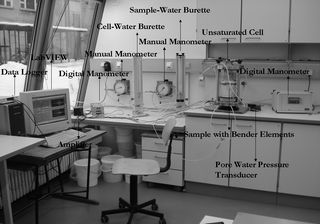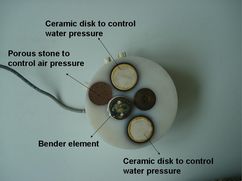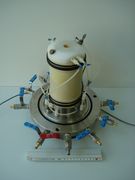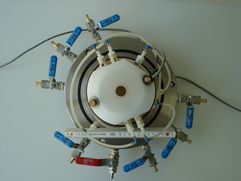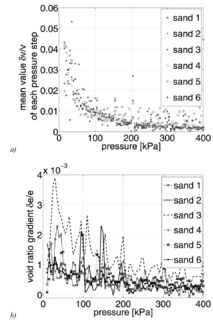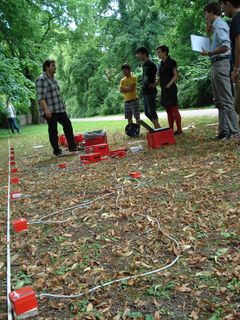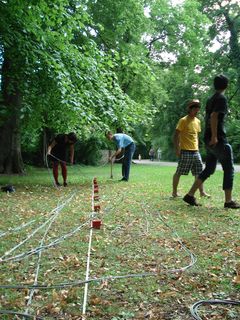Contact
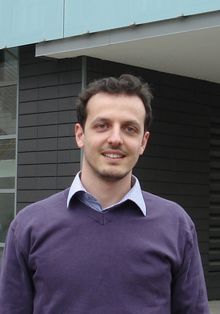
| Address: | Coudraystrasse 11c 99423, Weimar |
| Room: | 104 |
| Telephone: | +49 - (0) 3643- 58 - 4499 |
| Email: | milad.asslan[at]uni-weimar.de |
Fields of Interest
- Wave propagation in multi-phase granular material
- Unsaturated soil behavior at small strain
- Bender Elements (Experimental measurement & signal processing)
- Creep in sand
- Time-lapse monitoring
Research Topic
Determining small-strain shear modulus under multi-phase conditions in granular material:
The initial shear modulus Gmax of soil is an important parameter for a variety of geotechnical design applications. The critical role of soil stiffness at small-strains in the design and analysis of geotechnical infrastructure is nowadays widely accepted. Bender elements (piezoelectric elements) have been developed in recent years to investigate the small-strain parameters. In this research, the influence of soil suction on shear wave velocity is experimentally examined. From a theoretical stand point, signal processing methods are used to determine the actual velocity of shear waves and to better understand wave propagation in multi-phase granular material.
The experimental system of unsaturated cell with bender elements
The equipment needed for this research were designed by our group at Soil Mechanics laboratory at Bauhaus-University Weimar. A triaxial cell was modified to adopt bender elements. The bender elements are installed in the base and cap of the cell. A set of hardware and software equipment were put together to carry out the experiments. The wave is excited using LabView program through a data logger. A programming code was written using LabView programming language to allow recording and saving the output signal for further analysis. In this cell, air pressure and water pressure can be controlled separately using a porous stone and a ceramic disk respectively. This allows measuring shear wave velocity during change in matric suction for soil. An artificial material, uniform round glass beads, was used in addition to other granular materials.
Theoretical Approach
The experimental data of shear wave signal is analyzed and explained using the following techniques:
- Signal analysis & coda wave inteferometry
- Contact theory
- Numerical simulation
Results Sample
This figure shows shear velocity gradient and void ratio gradient with confining pressure for 6 sand samples. The gradient is calculated using the coda wave interferometry method. The figure suggests that higher change in velocity occurs at low confining pressure values. It is visible that void ratio curves have a decimal power less amplitude evolution and has a much more rough shape, which suggests that the evolution of velocity gradients is influenced by the contact stresses of the grains. To study that influence of the contact stresses between the grains, several mono-disperse glass beads specimen were analyzed by the coda wave interferometry. The change in the void ratio by using mono-disperse glass beads equals zero. The evolution of the velocity gradients between sand and glass is quite similar, which confirms the assumption that primarily the contact stresses are responsible for the evolution of the measured velocity gradients in the compacted specimen with low porosity change. This figure emphasize the importance of this technique in detecting very small perturbation in soil which are very difficult or likely not possible to detect by conventional methods.
-
 Results_Sample_10.pdf 538 KB
Results_Sample_10.pdf 538 KB
Teaching
- Lectures in Soil Dynamics (Master program, Natural Hazards and Risks in Structural Engineering)
- Lectures in Geotechnical Earthquake Engineering (Master program, Natural Hazards and Risks in Structural Engineering
- Field Survey & Laboratory Testing in "Introduction to Numerical and Experimental Geodynamics" in Bauhaus Summer school
Publications:
- Asslan, M. & Wuttke, F. (2012). Wave Velocity Change and Small-Strain Stiffness in Unsaturated Soils: Experimental Investigation. European Unsaturated Soil Conference, Napoli. (Abstract.pdf)
- Asslan, M. & Wuttke, F. (2010). An Experimental Study On The Initial Shear Stiffness In Granular Dry And Saturated Material Using Bender Elements Test. 14th European Conference on Earthquake Engineering, Ohrid. (Abstract.pdf)
- Asslan, M. (2009). An Experimental Study on the Initial Shear Stiffness in Granular Material under Controlled Multi-Phase Laboratory Conditions. Master thesis, Bauhaus-Universität Weimar.
- Wuttke, F., Asslan, M., & Schanz, T. (2012). Time-Lapse Monitoring of Fabric Changes in Granular Materials by Coda Wave Interferometry. Geotechnical Testing Journal ASTM, Vol. 35, No. 2.
- Wuttke, F., Asslan, M., & Schanz, T. (2011). Wave velocity analysis of state parameter changes in multi-phase granular materials. 5th International Conference on Unsaturated Soils, Barcelona, Alonso & Gens (eds). Taylor & Francis. pp 745-750. (Abstract.pdf)

